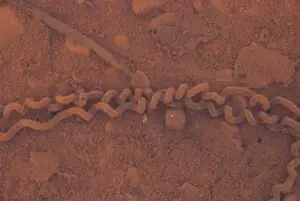Many frogs and toads look very similar, but they do have some differences. Most frogs lay their eggs in the water, and these eggs look like clusters of clear jelly-like globs, with developing embryos visible inside each egg. But what do toad eggs look like?
Most toads lay their eggs in shallow, calm, bodies of freshwater. The eggs are usually laid in long, jelly-covered strings (one to three eggs wide) along plants or resting on the pond bottom. Sometimes sediment settles on the egg strings, covering individual eggs and making them look like giant worms.
Some toad species, such as the eastern and the western narrow-mouthed toads do not lay their eggs in stings. Rather, they lay them in small packets that form a single-layered film on the surface of the water.
Other species such as the red-spotted toad lay their eggs singly. The small eggs may adhere to each other and form small clusters on the pond’s bottom.
Most Toads Lay Their Eggs in the Water
Most toads breed eggs in shallow, fishless, freshwater bodies. This could be in fishless ponds, seasonal pools, river margins, lake edges, river backwaters, bogs, marshes, swamps, temporary rain puddles, and even in roadside ditches, deep tire tracks, or potholes filled with rainwater.
In many species, the males arrive first at the breeding sites and call to attract females. Once the females arrive, the males will try to grab them from behind in a tight mating embrace called ‘amplexus’.
In more than 90% of toad species, the males are smaller than females and are always the ones on top.
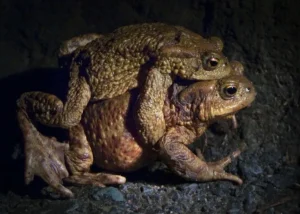
Once in the amplexus embrace, the pair will swim around as the female chooses a site to lay her eggs. The female then lays her eggs, usually in jelly-like strings, and the male releases sperm into the water, to fertilize the eggs as the female lays them.
Depending on the species, a female toad can lay anywhere from a few dozen, to as many as 40,000 eggs at a time.
Here Is What Toad Eggs laid in the water Look Like:
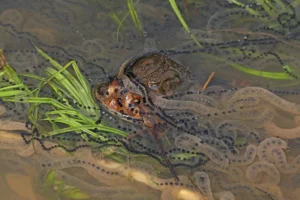

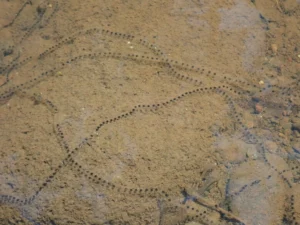

When first laid, the eggs are very tightly packed together. Over time, the jelly surrounding the eggs absorbs water until each egg is covered with a thick jelly coating.

This enables the eggs to float near the surface of the water, where it is warmer and there is more oxygen.
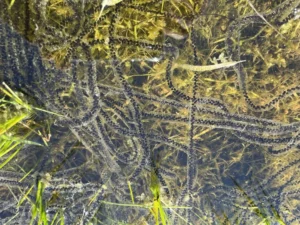
Sometimes, the egg strings coil up like an old phone cord and may have a double envelope surrounding the eggs. The jelly strings help anchor the eggs to rocks and vegetation underwater, to prevent them from washing away.

Over time, sediment may settle on the egg strands, covering individual eggs and making the strands look like giant worms.

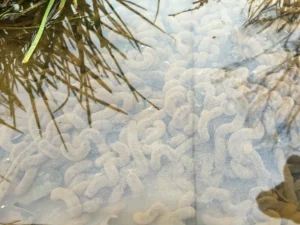
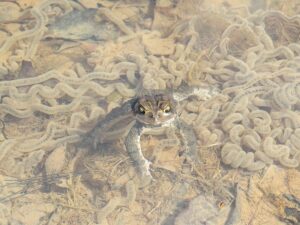
Some Toad Species Lay Their Eggs in a Film on the Water’s Surface
Not all toads lay eggs in long strings. Some species, such as the eastern and the western narrow-mouthed toads lay their eggs in small packets and form a single-layered film on the surface of the water.
The eggs look like small, floating dots and may be in small groups or a large raft, depending on how much they have been disturbed.
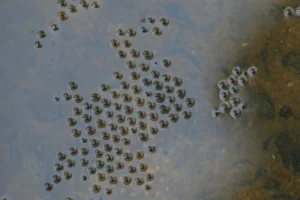
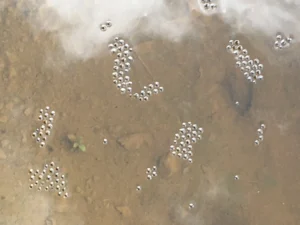

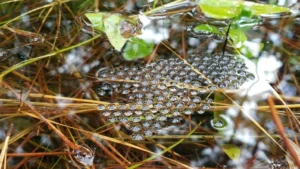
A Few Toad Species Lay Their Eggs Singly
A few toad species, such as the red-spotted toad lay their eggs singly. The small eggs may adhere to each other and form small clusters on the pond’s bottom.
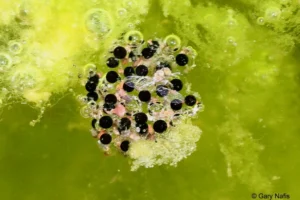
Oak toads, on the other hand, lay their eggs singly or in small strands of up to six to eight eggs, either free-floating or attached to vegetation.
Midwife Toads Carry Their Eggs on Land
Midwife toads are found in most of Europe and northwestern Africa. They get their name from the parental care they show for their eggs.
In these toads, the males carry the fertilized eggs on their backs, to protect them from predators present in the water.
When mating, the female releases an egg mass embedded in strings of jelly. The male then releases his sperm and inseminates the egg mass – then he pulls the egg mass so that he can wrap the strings around his waist and back legs.
Once the egg mass is wrapped, he can mate again – and carry up to 3 clutches, totaling about 150 eggs.
When mating is complete, the female leaves, and the male carries the eggs with him on land until they are ready to hatch, in about 6 weeks.
The male will keep the eggs moist by lying up in damp places during the day, and going into the water if the eggs risk drying out. He will also produce a skin secretion that protects the eggs from infection.
Here Is What Midwife Toad Eggs Look Like:

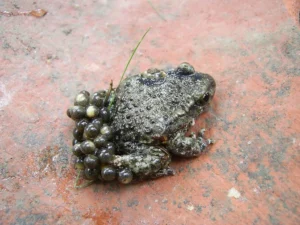
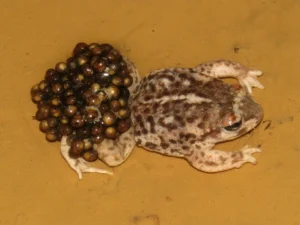
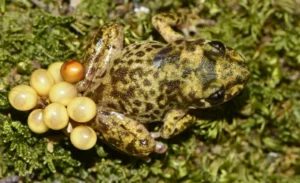
When the eggs are ready to hatch, the male wades into a shallow body of fresh water, and releases the tadpoles. Often, the eggs tadpoles are released into permanent water bodies, because they may overwinter before they complete their development in spring.
Some Toads Lay Eggs on Land
A few South American, and African toad species lay their eggs on land rather than in the water. The exact location the eggs will be laid depends on the toad species.
For example, Ethiopian mountain toads (Altiphrynoides malcolmi), lay their eggs near streams, or pools.
Unlike most other toads, Ethiopian mountain toads fertilize their eggs internally, then the female lays about 20 eggs enclosed in a mucus layer. The eggs are deposited either in the vegetation, under logs, or in leaf litter.
When the tadpoles hatch, they will not feed, but will instead be nourished by the large yolk-sack of their eggs, until they complete metamorphosis in a few weeks.
Saddleback toads (Brachycephalus) on the other hand, lay their eggs away from the water. They lay about 5 eggs in a hidden location, like under a tree log, or in leaf litter on land.
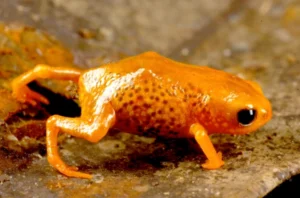
The female then rolls the eggs until they are covered in particles, making them blend in with the soil where they have been laid. It may also protect the eggs from drying out.
The eggs hatch into young fully developed toads with no tadpole stage.
The Differences Between Toad Eggs and Frog Eggs
Most frogs lay their eggs in large clusters. The eggs look like jelly-like globs, with a developing embryo visible inside each egg.

On the other hand, most toads lay their eggs in long jelly-covered strings, which may look like a string of black beads. No North American frog or European frog species lay their eggs in strings.
If you live in North America, Europe, or Australia and see amphibian eggs laid in long strings in the water, you can be 100% sure they are toad eggs.
In addition, the eggs of many (not all) toad species are poisonous to some degree, but the eggs of most frog species do not have any toxins.
The Differences Between Toad Eggs and Salamander Eggs
Salamander eggs are laid in masses, or individually, but never in strings like toad eggs. Unlike frog eggs, salamander egg masses have a protective outer jelly coat around the entire mass.
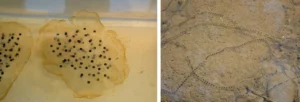
Salamander egg mass can lay anywhere from 6 to as many 700 hundred eggs, depending on the species. In comparison, toad egg strands can have more than 20,000 eggs.
The Differences Between Toad Eggs and Newt Eggs
Most newts lay eggs singly and wrap each egg with the leaf of a pond plant using their back legs. However, some newts lay their eggs in small masses. The egg masses are covered in an outer layer of jelly, just like salamander eggs.

Newts never lay their eggs in strings, so it should be fairly easy to differentiate toad eggs from newt eggs.
Surinam Toads Have a Unique Breeding Strategy
Surinam Toads are a fully aquatic toad species from the northern Amazon basin of South America. These toads are unique, in that the female gives “birth” to the young out of her back!
The female releases about 100 eggs during mating. Next, the male fertilizes the eggs and pushes them into the female’s back – and the skin of the female then encloses the eggs.
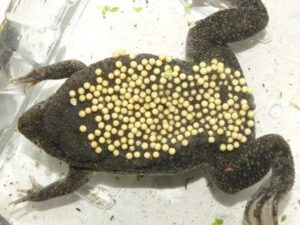
The embryos will develop to the tadpole stage inside of their egg pockets but will remain until they complete their development and become toadlets in about three to four months.
Once the eggs hatch, fully formed toads will pop out of the female’s back.
Not All Toads Lay Eggs
Although most toads reproduce by laying eggs, some species retain the eggs inside their bodies until they hatch, and then give birth to young fully-developed toads. This is known as “Ovoviviparity.”
A few ovoviviparous toad species are:
- Frontier forest toad (Nectophrynoides frontierei)
- Kihansi spray toad (Nectophrynoides asperginis)
- Pseudo forest toad (Nectophrynoides pseudotornieri)
- Western Nimba toad (Nimbaphrynoides occidentalis occidentalis )
- Minute tree toad (Nectophrynoides minutus)
More About Toad Eggs
Learn more about toad eggs in these interesting guides on our site:
Sources:
Bell RC, Zamudio KR. Sexual dichromatism in frogs: natural selection, sexual selection and unexpected diversity. Proc Biol Sci. 2012 Dec 7;279 (1748):4687-93. doi: 10.1098/rspb.2012.1609. Epub 2012 Sep 19. PMID: 22993253; PMCID: PMC3497084.
Allain, Steven J. R; Gandola, Robert; Tighe, Andrew; Wilkinson, John W. (2021). “An investigation into the provenance of Bedford’s midwife toads” (PDF).
Emma Cox; Karee Rasmussen; Philip Choy; Ann T. Chang (2013-02-25). “Altiphrynoides malcolmi”. AmphibiaWeb.
The life cycle of a North American toad. Encyclopædia Britannica. https://www.britannica.com/video/22455/life-cycle-toad-North-American
Rabb, G. B., & Snedigar, R. (1960). Observations on Breeding and Development of the Surinam Toad, Pipa pipa. Copeia, 1960(1), 40–44. https://doi.org/10.2307/1439843


